Do you know what these 8 badges mean?
Sitting in traffic can be boring. There often isn’t much to look at. A few personalized license plates to decode, or maybe a pretty sunrise or sunset to soak in, at best. I find myself often trying figure out what the badges on the back of the cars in front me you mean.
While the badging on modern cars is largely meaningless, there was a time when automakers peppered alphanumerics all over a car’s doors, fenders, pillars, and bumpers. It was a form boasting that showcased the car’s technological advancements and performance to anyone looking.
Those signals could be quite complex. You might need a decoder book, an engineering background, and an MBA to make sense of these four- or five-letter jumbles. These acronyms and initialisms pertained to the car’s transmission, engine, all-wheel drive system, or maybe a modest option code that sounded more like a radio station you’d pick up in the far corners of Kansas.
Thanks for tuning in to 94.3 SH-AWD! Up next we have a brand-new track off Sting’s new album!
We put our heads together and came up with a selection of badges—some well-known, some more obscure—and hunted down what each one meant. Should you stumble across one of these examples while gridlocked, the list below should provide you with some neat trivia to impress (or bore) your passengers.
LTD

While cars can sometimes seem like a Life Time Decision, that is not what LTD stands for. Nor does it stand for Love, Togetherness, and Devotion, but we could all benefit from being Back in Love Again with a quality automotive emblem like the Ford LTD.
No matter, when trim packages were introduced, the labels needed to create a hierarchy, clearly outlining which models were the feature-packed examples. Ford thought the best way to do so would be to make plain that one particular trim was Limited, which shortened nicely to LTD on the 1965 Ford Galaxie. Apparently it worked; by the late 1970s the Galaxie moniker was gone, and the LTD became the King of Dearborn.
RS/SS
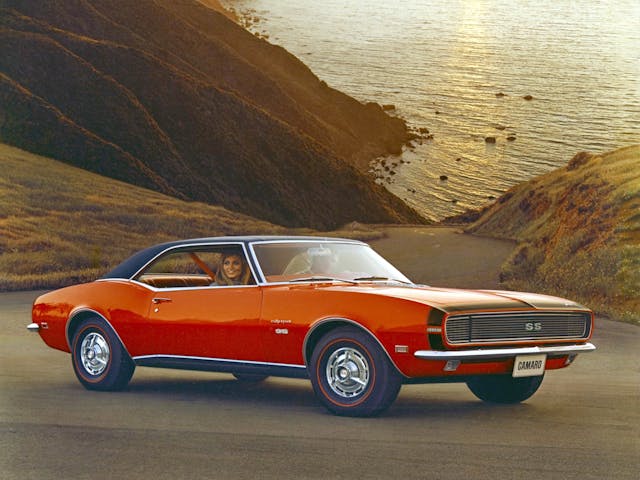
Just as Ford wanted to distinguish one trim as “Limited,” Chevrolet sought slice up the Camaro lineup in the late 1960s. Buyers could step up from the base trim to the RS, which stood for Rally Sport. Making the leap scored you hidden headlights, revised taillights, and some additional brightwork. From there, you could step up to the SS package, which was short for Super Sport and was targeted at buyers wanting additional power and handling capability.
4WS
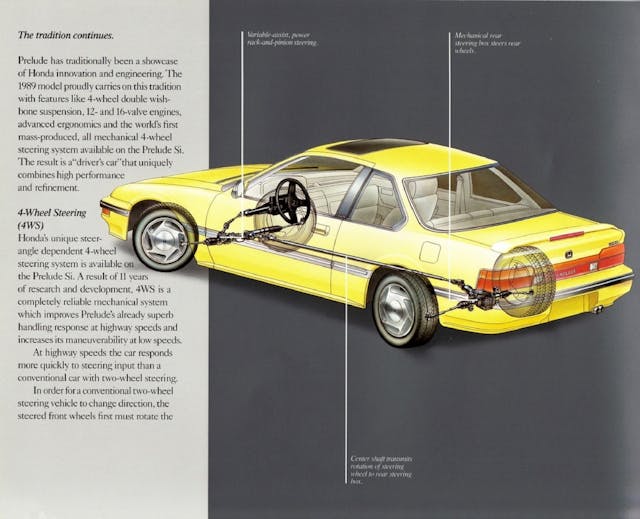
When numbers enter into the mix, you know things are getting complicated. Four Window System? The emblem was mounted on the B-pillar, after all!
But wait, that doesn’t make sense because this bit of tech debuted on the two-door Honda Prelude coupe. It’s actually a shorthand for Honda’s four-wheel steering, first introduced on the Prelude for the 1987 model year. The entirely mechanical system dialed in a relatively small amount of counter-steering to the rear wheels at slow speed to improve the turning circle, and it could also angle the rear wheels in the same direction as the fronts at higher speeds for better stability.
OHC/FI
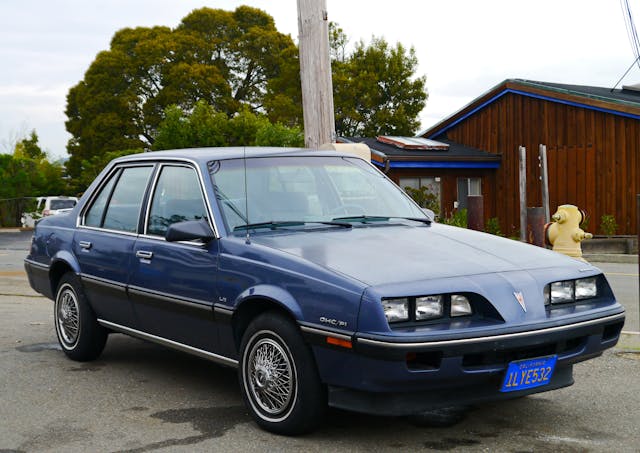
Five letters with a slash. Things are getting serious now! Or at least, Pontiac thought its tech was getting noteworthy with the combination of an overhead camshaft and fuel injection on the 1.8-liter fuel injected engines found in the J-body based Pontiac Sunbird. (This Opel-derived motor was also used in the Oldsmobile Firenza and Buick Skyhawk, but without Pontiac’s unique emblem.) Did many/most vehicles of the era feature at least one overhead camshaft and fuel injection? Well, sure. But were they advertising it on the front of the fender? Gotta respect Pontiac’s hustle.
SVT

Super Very Torque? I mean, you do only see this badge on quick cars. Born in 1991, Ford’s Special Vehicle Team (SVT) was a skunkworks division dedicated to niche high-performance vehicles. While not particularly a creative initialism, the team was responsible for some heavy-hitting machinery including the 1993 Mustang Cobra R, 2005–2006 Ford GT supercar, and the first Ford Raptor pickup. Ford formally closed down SVT in 2015, but the legacy of this badge will be remembered fondly in the hearts of Blue Oval fans everywhere.
ALB

Another Honda entry to the list, like the 4WS emblem, also appears on the B-pillar. While ALB sounds like a minor-league baseball organization, it’s not (we think). On Hondas, ALB was just a simple abbreviation for anti-lock brakes that predated the commonly used ABS (anti-lock braking system). Of course, ABS is ubiquitous and thus nothing to brag about, but ALB marks a time when it was something to be proud of.
HICAS and Super HICAS
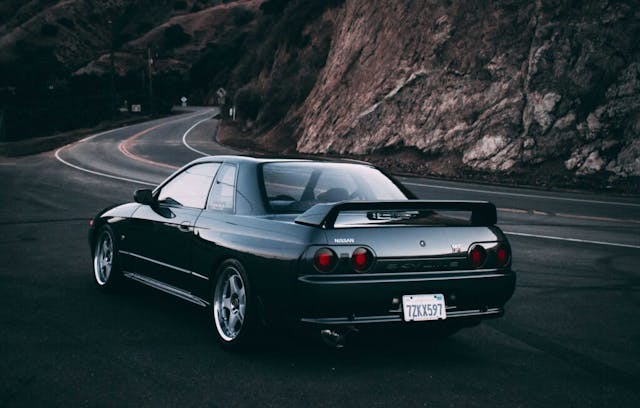
Whoa, that’s a lot of letters! HICAS stood for High Capacity Actively Controlled Steering, a rear-wheel steering system that Nissan first introduced on the 1986 Skyline GTS coupe. The system utilized the power steering pump to push fluid through a hydraulic circuit that would adjust the angle of the rear rollers based on input data from speed sensors. Starting with the R33 (1993–97) Skyline, the system swapped out the hydraulic controls for an electronically actuated system, which Nissan subsequently dubbed Super HICAS.
XR4ti

Where do we even start here? It is often safe to assume that ‘X’ is representative of ‘experimental’ in the land of European Ford and 1960s Lincoln-Mercury products—just pay no attention to the fact that Nissan came out with the Xterra and BMW stepped in with X-branded crossovers to muddied everything up. This particular string of letters does indeed start with ‘experimental,’ though it was only truly experimental for the North American market. From 1985 to 1989, Ford imported the three-door Sierra XR4i model and labeled it a Merkur XR4ti.
Long story short, XR4ti stood for Experimental (X) Racing (R),four cylinders** (4), Turbocharging (t), and fuel injection (i). That makes for a pretty cool package, but when shortened it looks more like a letter salad. Bob Lutz probably coulda been a little clearer with this one. That said, the 4 originally meant that it was the high performance version of the Ford Sierra, which was called the XR4.
You might be more likely to see these particular emblems at a RadWood event than in an everyday traffic jam, but knowledge is power nonetheless. We do occasionally have to eat and sleep, so we admit that what we’ve discussed here is a fraction of what is out there in wild, waiting to be decoded. Help us expand the list with a comment below and share your knowledge!
**There’s some intentional confusion here, as the “XR4” in XR4ti was originally designated as the largest of the three experimental racing creations from Ford of Europe. There was the smaller Escort XR3 and Fiesta XR2 before it. So you can either refer to it as four cylinders in American parlance, as it makes complete sense with the “t” and the “i” after, or the original definition of it being a larger hatchback in Ford’s performance portfolio.
***
Check out the Hagerty Media homepage so you don’t miss a single story, or better yet, bookmark it. To get our best stories delivered right to your inbox, subscribe to our newsletters.
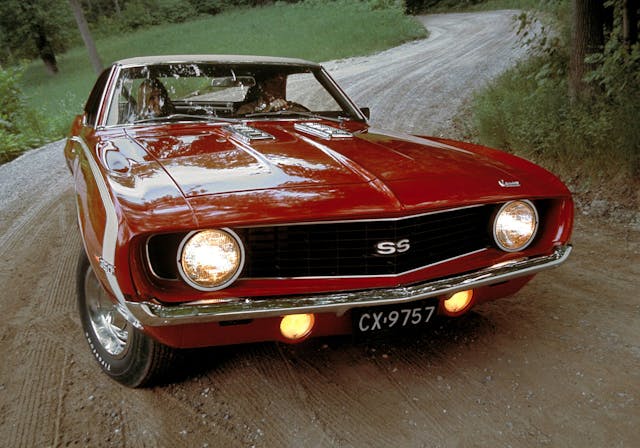


The author is a little wrong on the XR4TI. Ford labelled all its European higher performance cars with the XR badge. The XR2 was the hot Fiesta and the XR3 was the hot Escort. The next size Ford vehicle was the Sierra and the hot European Sierra was the XR4i with the ‘i’ noting the engine was fuel injected (the even hotter Sierra Cosworth would come later). The US-spec car could not use the Sierra name and added ‘T’ to note it was turbo-charged.
Did Ford market the XL at the same time as the LTD?
Yes they did, but the XL was the performance version of the Galaxie 500. You could get an LTD hardtop coupe, but the XL was the hardtop with the bucket seats and console.
I was always puzzled by the Mercury Cougar XR7.
By that, I mean, I don’t know about the X, the R or the 7.
Much like the XR4ti, the X and R stood for eXpermimental Racing. The 7 was part of T-7, which was the codename for the Cougar before it got its publicly facing name. And T7 is related to the T5 that was the Mustang: https://www.hagerty.com/media/car-profiles/german-for-mustang/
Another one that gets many different answers is the good old “442”.
TLDR
What, no SROD? That was the 4 speed transmission designation (Single Rail Over Drive) on the 1979 Mustang 5.0L and other FoMoCo products. Huge gear ratio spacing.
Re: 442: I may be wrong, but I seem to recall that the first Olds 442 was a ’64 with the new light-weight 334 cid V8. The name “442” came from “4” on the floor, “4” bbl carb, and “2” dual exhaust.
I always thought the badging that bragged about at least semi-ubiquitous features such as EFI, ABS, etc. was goofy. If the average other new car has the same feature, how is anyone supposed to be impressed? Ooh, EFI! 🙂 When a feature is new and the brand is a pioneer in deploying it, yes, tout that. But once 40 or 50 percent of decent new cars have it, it’s not special anymore. In my mind, just the opposite happens when I see things like that: the car must not have much great to say about itself if it can only tout features every other car has, too.
Another “Experimental” was the AMX, for American Motors Experimental
i thought LTD meant Long Tome Debt?
And, of course: CJ-2A, CJ-3A, CJ-3B, CJ-5, CJ-6, CJ-7, CJ-8…when Civilian Jeep was more regularly understood.
LTD stood for Lincoln Type Decor. The interior was upgraded to look more like Lincoln’s. Pleated seats/upgrade material , wood grain on dash and door panels, later models had hidden headlights. This was told to me by an old Ford employee who had been to training back at the Ford headquarters. When I compared the two I definitely saw what looked like Lincoln influence on the LTD models. Plus I trusted the guy, he always was straight with me.
My Dad was a Ford owner for many years and was told that LTD meant “Lincoln Tooled Down” and in many ways that made sense. It usually had a big engine, big brakes and a plush interior – like a smaller Lincoln.
An SS could also be an RS, but an RS couldn’t be an SS. Got that? 🙂
Surprised nobody mentioned Ford’s Super High Output (SHO) moniker.
If the four in XR4Ti stood for four cylinders, what did the four stand for in Sierra XR4i, which had a V6?
You have a point, in Europe the “4” was to show it was a bigger body style than the Fiesta XR2 and Escort XR3. I will address this error.